Giochi dell'Oca e di percorso
(by Luigi Ciompi & Adrian Seville)
(by Luigi Ciompi & Adrian Seville)

|
Giochi dell'Oca e di percorso
(by Luigi Ciompi & Adrian Seville) |

|
 |

Torna alla ricerca giochi (back to game search) |
 |
| Chronological (The) Star of the World. An Entertaining Game. | ||
 |
Versione stampabile
 |
Invia una segnalazione

|
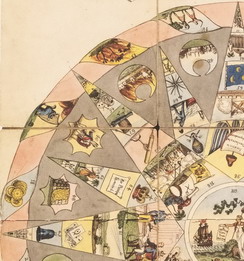 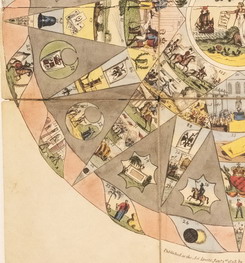 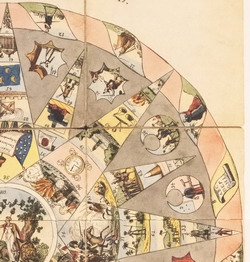 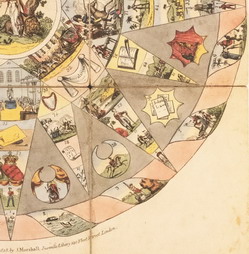  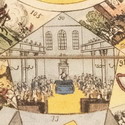 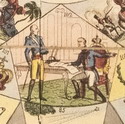 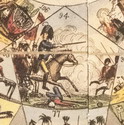 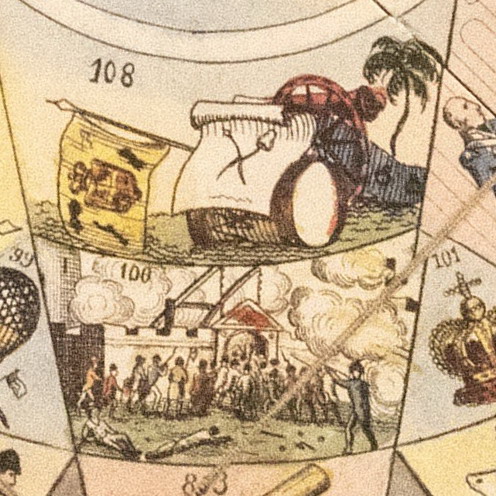 |
primo autore: | Anonimo |
| secondo autore: | Non indicato | |
| anno: | 1818 | |
| luogo: |
Inghilterra-Londra |
|
| periodo: | XIX secolo (1°/4) | |
| percorso: | Percorso di 109 caselle numerate | |
| materiale: | carta (paper) (papier) | |
| dimensioni: | 565X483 | |
| stampa: | Litografia (Lithographie colorié au pochoir) (engraving) | |
| luogo acquisto: | ||
| data acquisto: | ||
| dimensioni confezione: | ||
| numero caselle: | 109 | |
| categoria: | Religione, Diritto e Morale | |
| tipo di gioco: | Gioco di percorso | |
| editore: | Non indicato | |
| stampatore: | Non indicato | |
| proprietario: | Victoria&Albert Museum, London | |
| autore delle foto: | L. Ciompi | |
| numero di catalogo: | 2376 | |
| descrizione: |
Gioco di percorso di 109 caselle numerate. REGOLE: non riportate sul tavoliere. CASELLE: mute. REFERENZA 1 "The Chronological Star of the World. An Entertaining Game".(V&A Museum) Physical description Design: engraving, coloured by hand; 9 sections mounted on linen showing a circle with a star pattern of 8 large points alternating with 8 small points, with crescent and star shapes a ribbon pattern around outer edge. No. of squares: 109, all illustrated and numbered Squares titled: none Subject of starting square: Garden of Eden Subject of ending square: Abolition of Slavery No. of Players: any Equipment required: teetotum, markers and counter Rules placement: none, probably within a booklet Rewards: not known, however, there would be a kitty or pool with each player having a given number of counters for rewards; forward movement. Forfeits: payment of counters and backward movement Rules: The game is played anti-clockwise with No. 1 at the bottom of the point which is in the central position at the bottom of the game. The first 24 are alternately the points and the ribbon illustrations around the outer edge. Nos. 25 to 56 combine the second illustration in the large points, the first illustration in the small points and the illustrations in the stars and crescents. These two designs are in the spaces between the points and form an alternating pattern of two crescents, two stars. The rest of the numbers are shown on the points and around the central illustration (109) which is dedicated to the Abolition of Slavery. 1. Garden of Eden 2. Noah's Ark and the Great Flood 3. David and Goliath 4. fountain or domed pillar, shrine 5. queen in a chariot or wagon with standard and soldier 6. Flight into Egypt 7. man in red with spear 8. scroll with the letters A to I 9. man in blue with woman in red 10. water with fireworks or possibly Moses in the bullrushes 11. sailing boat 12. man in red and blue with pole or lance 13. man standing in green with a man in the green part 14. two men fighting 15. burning bush 16. walled town 17. man playing a harp 18. gold coins 19. house being built, with scaffolding 20. knight on horse with tent in background 21. men building a house, one with a wheelbarrow 22. eclipse of the sun 23. teacher/orator/prophet in red and blue with scroll 24. eclipse of the sun 25. man in red and blue holding lute 26. king on a throne (in crescent) 27. sword and chalice 28. man on horseback, galloping (in crescent) 29. man on horseback in stockade behind (looks like a Hussar) 30. sheets of paper with one marked SOLON'S LAWS (in star) 31. man collapsed on chair 32. man being knighted, or a stage play of same with red curtains (in star) 33. sailing boat 34. astronomer, possibly Gallaleo 35. sheets of paper 36. three soldiers, appear to be Spanish but setting looks Middle Eastern 37. burning town 38. soldier fighting native, appears to be Roman 39. fighting in a building 40. woman on stage 41. colonaded building 42. town 43. man on chains and leg irons 44. burning town 45. destroyed buildings 46. king on a throne 47. man on horseback 48. bales of cloth 49. bell 50 coat of arms, with crown 51. Fleur d'Ilys 52. men in blue greeting soldiers from a ship 53. burning ships 54. tomb 55. man on galloping horse 56. knight on horseback 57. crown resting on a red shield 58. scroll with the numbers 1 to 0 59. man with shield and sword 60. men in battle scene 61. men marching in desert scene 62. cone in brown and white, may represent obelisk or even sugar 63. scales 64. windmill 65. blue flag with three gold crescents 66. star with multiple points (similar to the star on the Nuremburg House) 67. cannon, rifle, shot and gunpowder barrel 68. man in orange holding flag similar to that in 65. 69. playing cards 70. printing press 71. battle with horse and foot guards 72. battle of footguards before a building 73. letter/envelope in gold 74. battle footguards and horseman 75. ship sailing near land 76. book and quill 77. native leader/king 78. troops marching, appear to be Turks 79, ship sailing between two land points 80. ship's cannon mounted on wheels 81. raised flag, white with red X 82. man in blue landing from ship's tend with ship in the background 83. telescope 84. sheet of paper with AIR PUMPS INVENTED 85. farm scene with shooting star or meteor 86. flag, white with black double headed eagle 87. mounted soldier 88. flag, white with double headed eagle but of a different design to 86. 89. battle scene 90. parliament or court scene 91. shield or mirror shaped as a shield draped with red cloth 92. white draped cloth with INOCULATION 93. king seated beside table 94. battle scene, probably General Wolf 95. destroyed buildings 96. clock face 97. white sheet with red central seal 98. flags and scroll with AMERICA DECLARATION INDEPENDENCE 99. hot air balloon 100. battle scene, men storming a city gate 101. crown 102. king, seated at table holding audience with another man 103. dove of peace 104. men landing from ships 105. battle scene, possibly Duke of Wellington 106. horse drawn royal coach 107. sea battle 108. defeated army relics, flag, cannon and drum 109. woman under tree with ship flagged FREEDOM n the background with a scroll lettered TO THE GLORY BRITAIN SLAVE TRADE ABOLISHED Marks and inscriptions J Marshall, Juvenile Library 140 Fleet Street ; published as the acts directs, Jany 1st, 1818 Dimensions: length: 22.25 in, width: 19 in Object history note The game should have a booklet which would provide the rules and a description of each square. These combine biblical and historical details with inventions and some scientific events. John Marshall was at address from about 1805 to 1828. He was a great rival of Elizabeth Newbery. See also the Infant's Cabinet of Fishes (Card Games) Descriptive line The Chronological Star of the World, J Marshall, English, 1818 Bibliographic References (Citation, Note/Abstract, NAL no) Collector's Guide to Chidren's Games & Puzzles, CG Goodfellow, Apple Press, 1991 REFERENZA 2 The Chronological Star of the World - Der Zeitstern der Welt London, 1818 Radierung, handkoloriert, 56,51x48,26 cm Verlag: John Marshall, London Sammlung: Victoria and Albert Museum, London (Inv. -Nr.: B.1232-1993) John Marshall (1756-1824) waere kein Freund von Harry Potter gewesen. Der ueberaus erfolgreiche Londoner Kinderbuchverleger und Herausgeber von Jugendmagazinen war ein Paedagoge mit klaren Prinzipien: Sein Verlagsprogramm, kuendigte Marshall in einem Katalog an, unterscheide sich von anderen dadurch, dass es frei sei vom "schaedlichen Nonsens der Maerchen, der Kobold-, Hexen- und Liebesgeschichten, die es im Ueberfluss gibt und die in den Gehirnen von jungen Menschen wenig sinnvolle Wirkung zeitigen". Der Aufklaerer (und gerissene Geschaeftemacher) setzte programmatisch auf Belehrung und auf die Macht des Wissens. 1818 publizierte Marshall The Chronological Star of the World. Das Spiel ist grafisch sehr anspruchsvoll gestaltet: Als Spielflaeche dient ein Stern mit 16 sich ueberlappenden Zacken, die jeweils vier bis sechs Felder enthalten. Weitere sichel- und kreisfoermige Felder finden sich zwischen den Zacken und am gewundenen Band, das die Spielflaeche umschliesst. Erzaehlt wird eine Weltgeschichte auf 109 Feldern, und zwar nicht als ein Sammelsuriurn von Geschichten, sondern als zielgerichteter Weg des Fortschritts, dessen Errungenschaften den Menschen Schritt fuer Schritt zur Vernunft bringen. Am Anfang (Feld 1) darf der Spieler einen Blick in den Garten Eden werfen, am Ende ist eine wehrhafte Goettin mit Union Jack am Schild und dem britischen Loewen hinter sich zu sehen. Sie weist dem Schiff Freiheit den Weg, in der Hand traegt sie ein Flugblatt mit der Aufschrift: "Zum Ruhme Britanniens Sklavenhandel abgeschafft". Auch wenn die Regeln des Spiels und die Beschreibungen verloren gegangen sind, lassen sich viele der Stationen auf dem Weg zur Freiheit bestimmen. Zunaechst dominieren biblische Themen wie die Sintflut (2). lm Laufe des Spiels werden aber auch Momente der technischen und zivilisatorischen Entwicklung der Menschheit hervorgehoben, wie die Erfindung der Schrift (8), das Muenzwesen (18), Entdeckungsfahrten (11, 33), die Etablierung von Gesetzen (30) oder die Einfuehrung der arabischen Zahlen (58). Praesentiert wird die Entwicklung der Astronomie (34), der Raederuhren (96), des Teleskops (83) oder des Heissluftballons. Ein besonderer Moment, der ein prominentes Feld beansprucht, ist die Deklaration der amerikanischen Unabhaengigkeitserklaerung im Jahr 1776 (98). Wie bei Hegel ist der Lauf der Geschichte im Spiel zwar eine Einheit, zugleich aber auch ein dialektischer Prozess, in dem Gegensaetze in Permanenz aufeinanderprallen. Die gloriosen Momente werden staendig von martialischen Szenen unterbrochen. Spielregeln (Vorschlag) In einem Zeitalter, in dem uns der Glaube an Fortschritt und die Teleologie der Historie ein wenig abhandengekommen sind und geschichtsphilosophische Skepsis das Bewusstsein der Menschen dominiert, liesse sich The Chronological Star of the World vielleicht am besten als Konversationsspiel spielen. Wer durch Wuerfelwurf ein Feld betritt, muss den positiven Beitrag zum Fortschritt, den das Bild zeigt, argumentieren, ein Gegenredner wird diesen Fortschritt in Abrede stellen und das Gegenteil behaupten, Danach wird ueber Rede und Gegenrede abgestimmt. lst der Fortschrittsoptimist glaubwuerdiger, so darf er die Punktezahl verdoppeln. (Ernst Strouhal) |
|
| bibliografia: |
1) GOODFELLOW, Caroline: "Jeux de société. Le guide du collectionneur des jeux de société depuis le XVIIIe siècle jusqu’à nos jours", (Edizione francese) Carrousel MS, 2001.1) 2) GOODFELLOW, Caroline: "A Collector's Guide to Games and Puzzles" Secaucus, New Jersey, Chartwell Books-London, Quintet Publishing Limited 1991. 3) GOODFELLOW, Caroline: "The Development of the English Board Game, 1770-1850", in Board Games Studies 1, 1998. 4) SEVILLE Adrian: "The geographical Jeux de l'Oie of Europe." In "Belgeo" 2008 3-4 2008. 5) SEVILLE, Adrian: "The Game of Goose: and its influence on cartographical race games" Journal of the International Map Collectors' Society, Winter 2008 N°115 2008. 6) WHITEHOUSE, F.R.B: "Table Games of Georgian and Victorian Days", Peter Garnett 47, Welbeck Street, London 1951. 7) STROUHAL, Ernst: "Die Welt im Spiel. Atlas der spielbaren Landkarten”. Christian Brandstaetter Verlag. Universitat fur Angewandte Kunst, Wien. 2015 |
|
Vai alla ricerca giochi Vai all'elenco autori